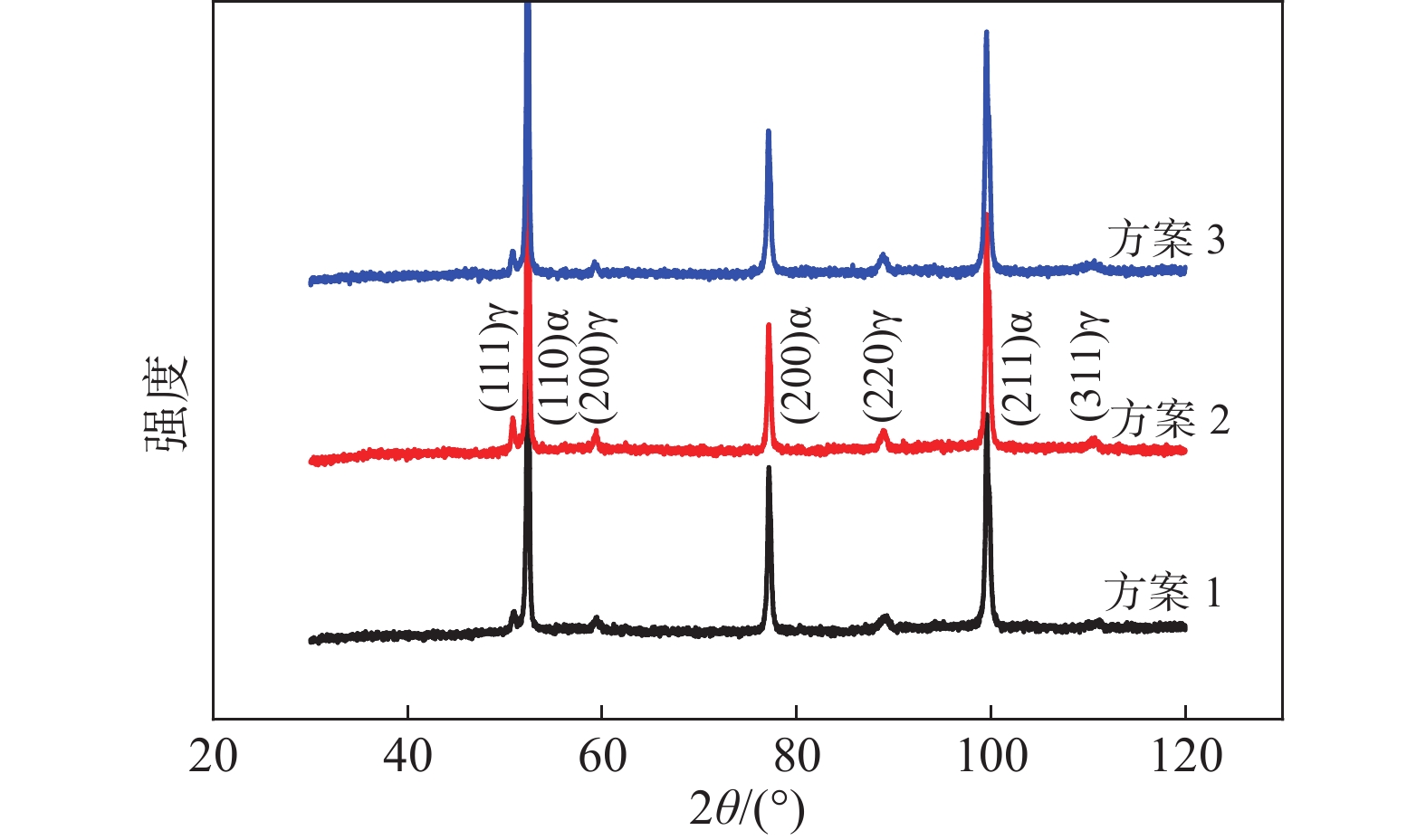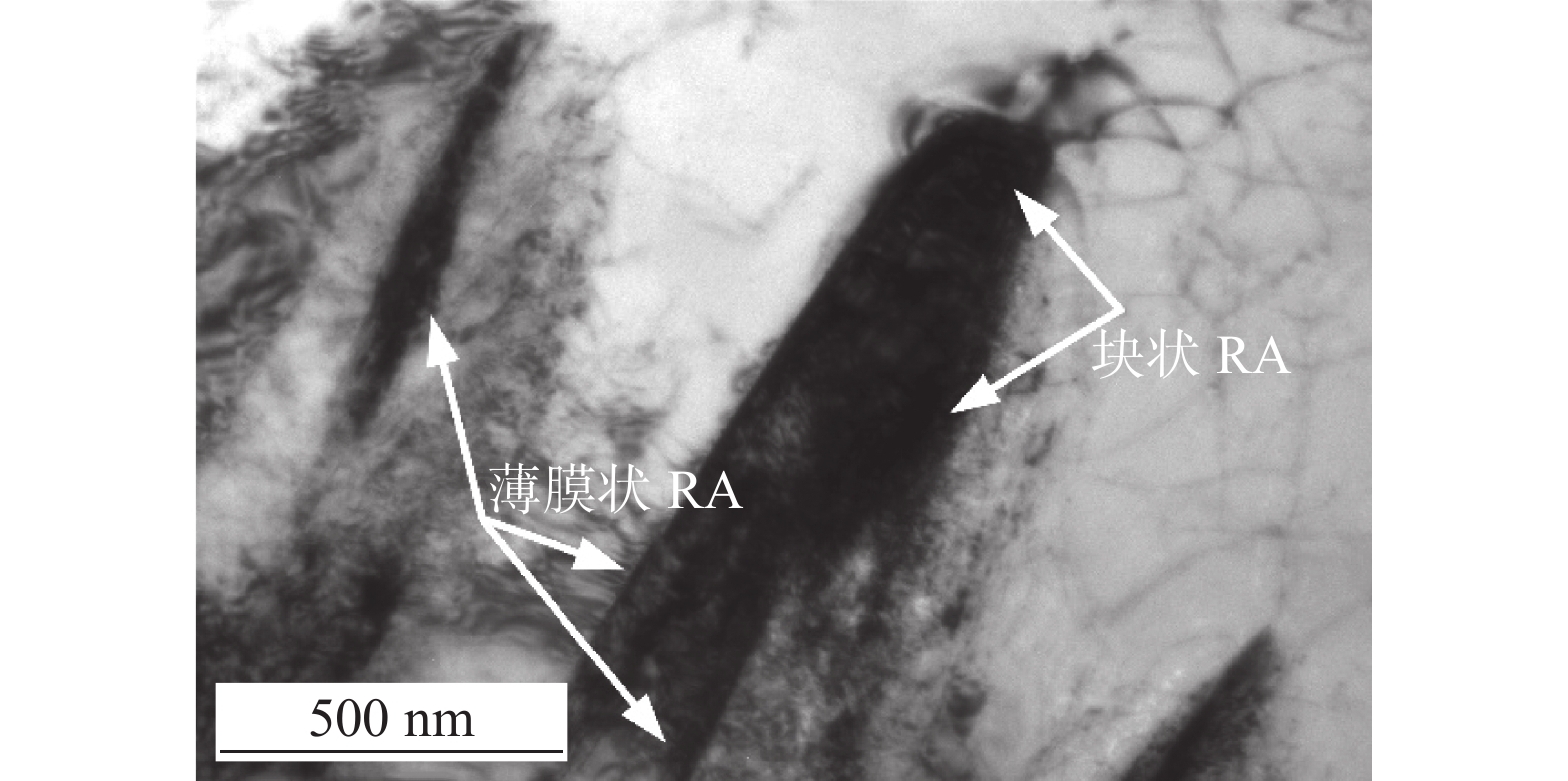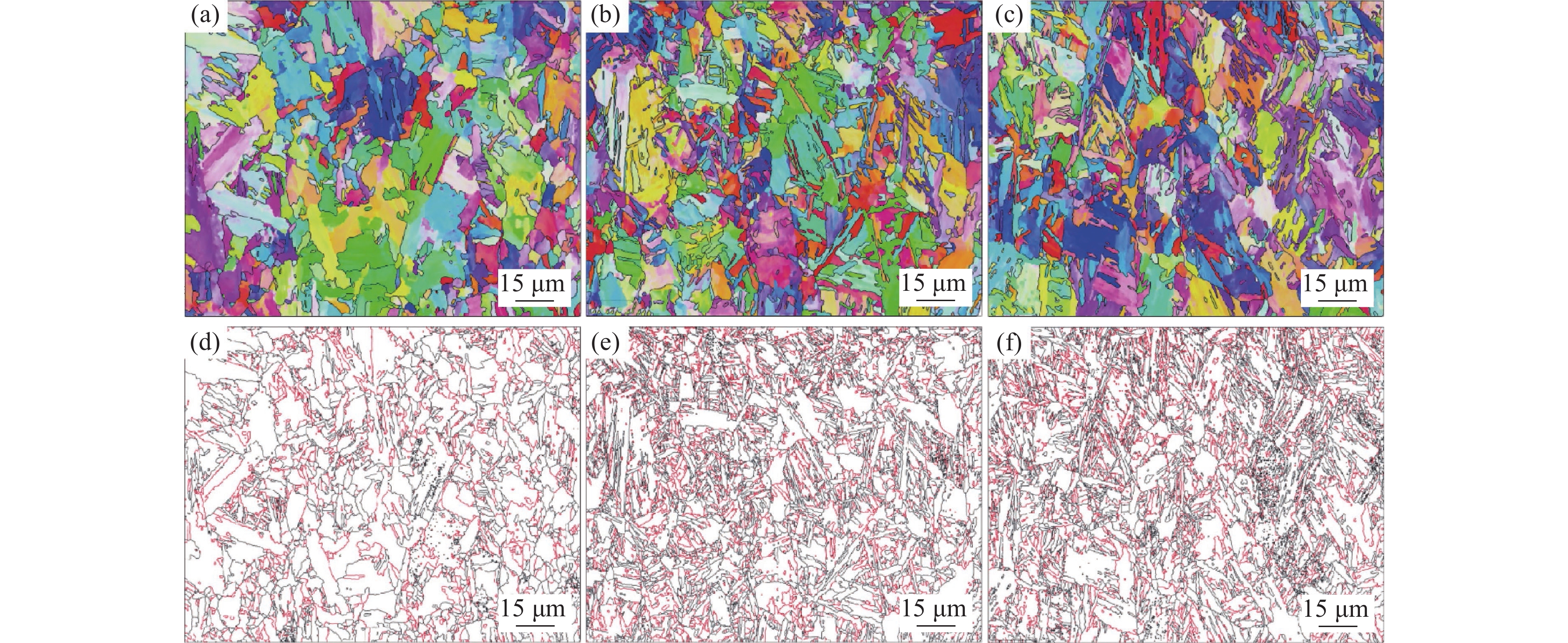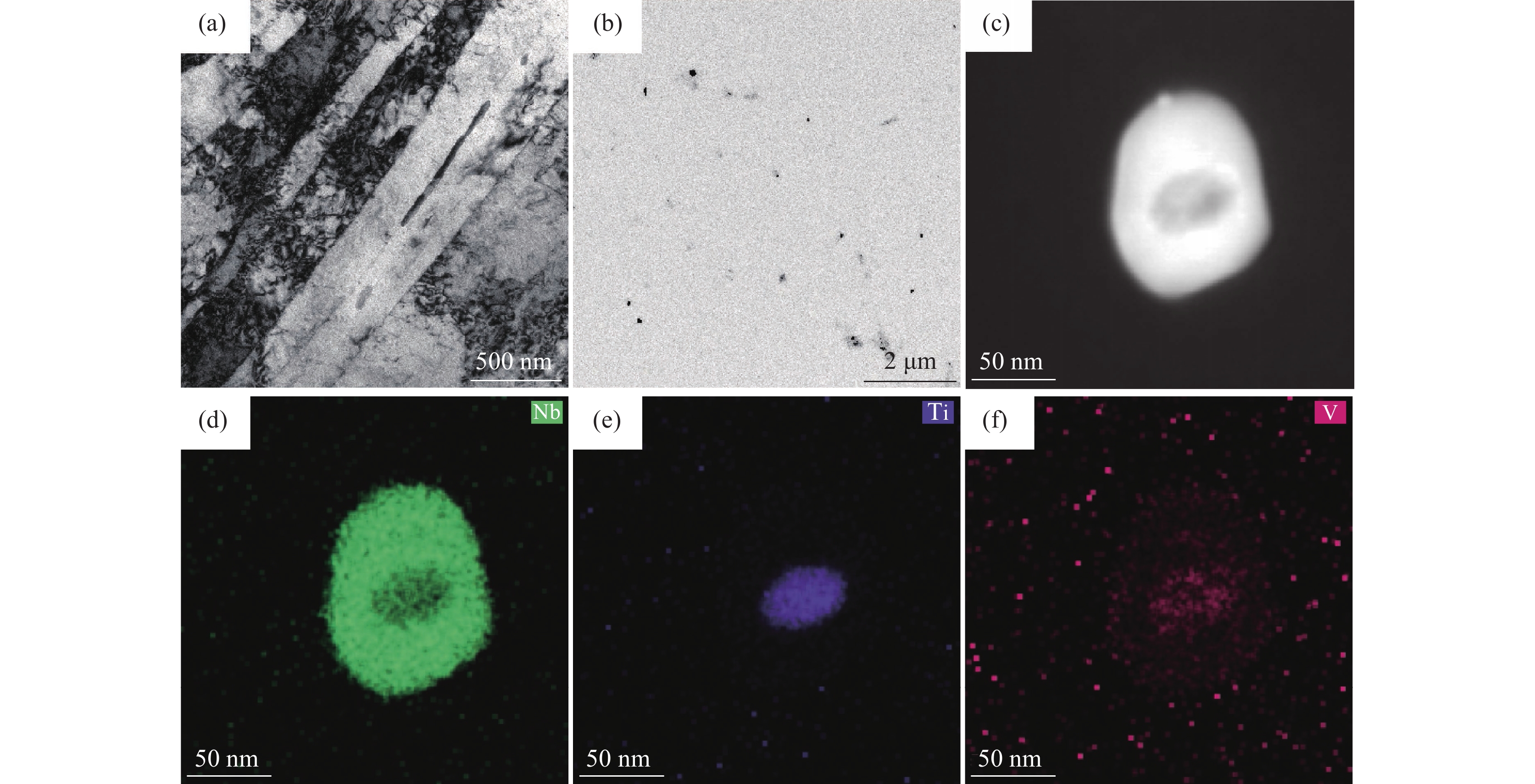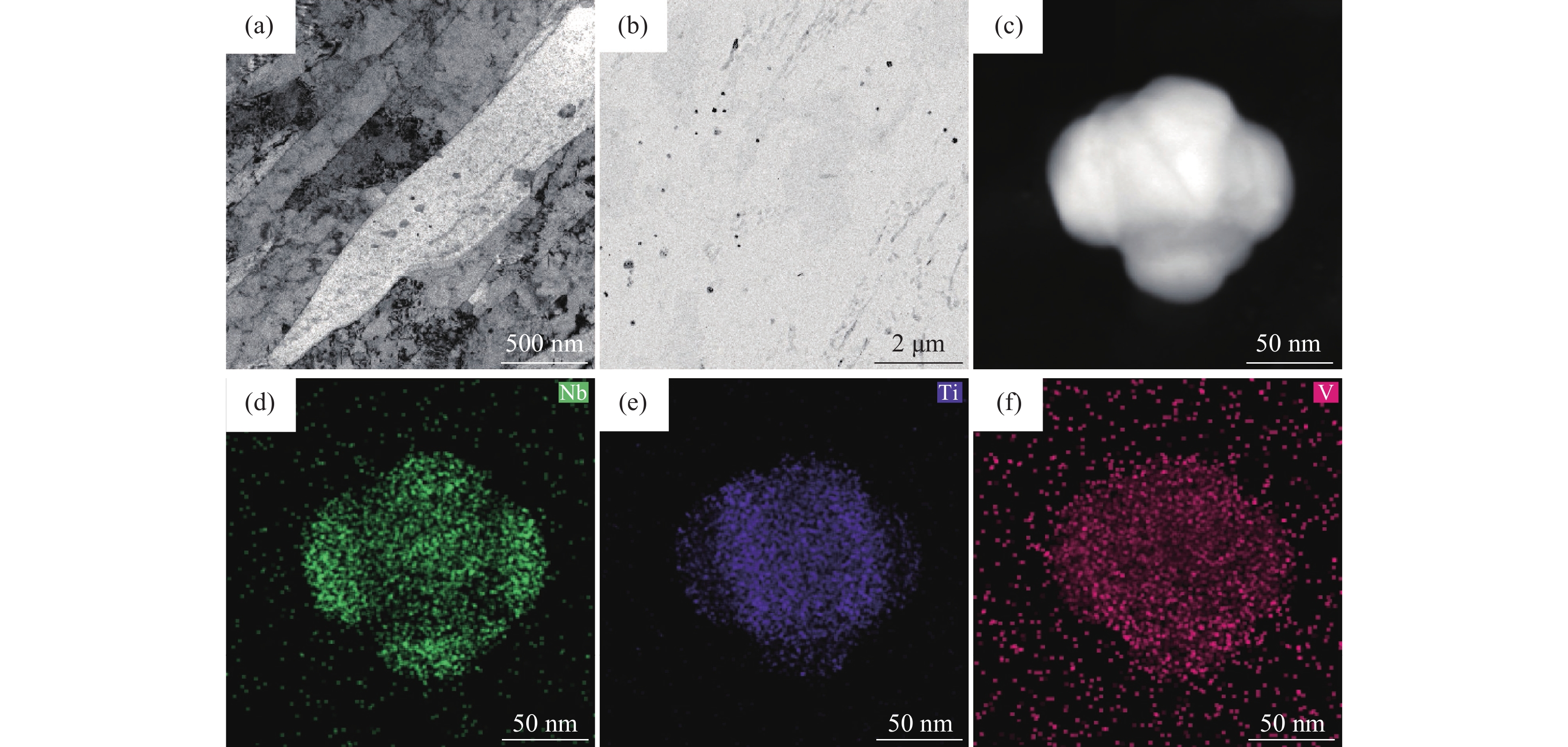Effect of continuous annealing process on microstructure and properties of 780 MPa cold-rolled dual phase steel with high formability
-
摘要: 基于产线装备特点设计开发了一种低成本780 MPa级冷轧增强成形性双相钢,并开展连续退火工艺对其组织性能影响的研究。结果表明:不同退火工艺条件下试验钢显微组织主要为铁素体与弥散分布的贝氏体、马氏体和少量马奥岛;快冷结束温度的提高有助于残留奥氏体含量的提升,最高残留奥氏体含量达到3.9%;残留奥氏体呈薄膜状或块状,多分布于B/F与F/F或B/M相界面处,残留奥氏体发挥TRIP效应实现塑性提升。Abstract: A low-cost 780 MPa grade cold-rolled dual phase steel with high formability was designed and developed based on the equipment characteristics of the production line, and the effects of continuous annealing on the microstructure and properties of the cold rolled products were studied. The results show that under different annealing conditions, the microstructure of the experimental steel is mainly composed of ferrite, dispersed bainite, martensite, and a small amount of M/A islands. Increasing the end temperature of rapid cooling can increase the retained austenite content, with the highest content of retained austenite reaching 3.9%. The retained austenite is mostly distributed in the form of thin films or blocks at the interface between B/F and F/F or B/M phases, and the retained austenite exerts the TRIP effect to achieve plasticity improvement.
-
Key words:
- dual phase steel /
- annealing process /
- retained austenite /
- TRIP effect /
- mechanical property
-
0. 引言
20世纪以来,天然气和石油等资源的需求日益增加,这对长输管线提出了耐高压、厚管壁、大口径的要求。其中,在长输管线铺设的过程中,需要大量与干线管道配套的弯管。热煨弯管以其质量可靠、适用性强、生产效率高等优势,被广泛应用于各类管道的建设中。然而,由于服役过程中结构特殊性以及复杂的受力条件,使得热煨弯管成为管道事故的多发部位,其综合性能直接影响到管道质量和管道运行安全[1]。目前,热煨弯管大多数通过感应加热+回火的调质工艺弯制而成,需要精确控制热处理工艺保证弯管的性能[2]。
微合金化是管线钢常用的关键技术[3]。常用的微合金元素为Nb、Ti,通过和C、N元素结合形成纳米碳化物。对于以TMCP工艺生产的管线钢来说,碳氮化铌和碳氮化钛在轧制前就已析出,通过阻碍晶粒长大、为奥氏体-铁素体提供形核位点、拓宽奥氏体非再结晶区轧制工艺窗口等方式来同时提高材料的强度与低温韧性[4−5]。此外,弥散分布的纳米碳化物能够起到沉淀强化的作用;当它们存在于晶界上也有助于抑制裂纹扩展,从而提高钢的韧性。
一般来说,V很少用于管线钢生产中,因为碳氮化钒的析出温度在600 ℃左右,在TMCP工艺生产的管线钢中难以析出。然而,热煨弯管用管线钢在制管时会经过回火,这有助于V的析出和提高管线钢强度[6-7]。目前,对热煨管线主要研究集中在热处理工艺上,针对Nb、V复合微合金化对于管线钢的组织性能的影响研究较少。笔者利用SEM、TEM等试验设备和热动力学计算探究Nb、V微合金元素复合添加对于X80热煨弯管钢显微组织和力学性能的影响,旨在为X80热煨弯管钢的强韧性设计提供成分参考。
1. 试验材料和方法
试验钢采用真空感应炉冶炼,浇铸成80 kg铸锭,其化学成分如表1所示。根据Nb、V添加量分别命名为06Nb1V试验钢、02Nb1V试验钢、06Nb04V试验钢。钢板的热处理工艺如表2所示。
表 1 试验钢化学成分Table 1. Chemical compositions of three tested steels% 试验钢 C Si Mn+Cr+Mo Ni+Cu Ti Nb V Al Fe 06Nb1V 0.07 0.25 2.2 0.3 0.03 0.06 0.1 0.03 Bal. 02Nb1V 0.07 0.25 2.2 0.3 0.03 0.02 0.1 0.03 Bal. 06Nb04V 0.07 0.25 2.2 0.3 0.03 0.06 0.04 0.03 Bal. 表 2 试验钢的生产工艺参数Table 2. Production process parameters of the investigated steels奥氏体化温度/℃ 奥氏体化时间/min 冷却方式 回火温度/℃ 回火时间/min 950 40 水冷 600 60 按照GB/T 228.1—2010《金属材料拉伸试验第1部分:室温试验方法》与GB/T 229—2007《金属材料夏比摆锤冲击试验方法》对试验钢进行室温拉伸和−20 ℃冲击试验。对试样进行打磨、抛光后,用4%硝酸酒精腐蚀,并用金相显微镜观察其微观组织。将试样进行电解抛光后,应用场发射扫描电镜进行背散射衍射(Electron Backscatter Diffraction, EBSD)测试。将试样进行电解双喷后,应用FEI Talos F200i型透射电子显微镜(Transmission Electron Microscope, TEM)观察微观组织。将试样表面进行喷碳,深腐蚀后制备萃取复型碳膜,然后利用透射电镜对析出相进行表征。采用McCall-Boyd法计算析出相的体积分数[8],如式(1)所示。
$$ f=\frac{1.4{\text{π}} }{6}\times \frac{N{d}^{2}}{A} $$ (1) 式中,N为试场中析出相的数量,d为析出相的平均直径,A为被统计视场的面积。利用Thermo-calc软件计算试验钢热力学平衡相的变化。
2. 试验结果与讨论
2.1 热力学计算
利用Thermo-calc软件进试验钢热力学计算(TCFE10铁基数据库)。图1为06Nb04V试验钢的热力学平衡相图及局部放大图。在钢板轧制过程中,温度降低至
1100 ℃左右时,部分Nb和C结合生成NbC,其余Nb固溶于奥氏体中,这将抑制奥氏体再结晶,阻止界面迁移,从而控制奥氏体晶粒尺寸,提高相变形核率,细化贝氏体晶粒[3]。冷却到700 ℃时,VC开始析出。由于钢板控制冷却,冷速较快,VC析出量较少。在后续的回火过程中,Nb和V会进一步析出。由于V在奥氏体中的固溶度较大,在回火时候会析出更多的VC相。在500 ℃时,钢的基体相为BCC_A2,含量较少的相为FCC_A1#2((Nb,Ti)C),FCC_A1#3(VC),MC_ETA((V,Mo)C),CEMENTITE_D101(Fe3C),M7C3_D101((Fe,Mn)7C6)。2.2 微观组织观察
图2为不同Nb、V含量试验钢在SEM下的微观组织。三种试验钢均由贝氏体铁素体、多边形铁素体及亮白色的M/A岛组成,组织形态分布均匀。一般而言,多边形铁素体相有助于提高钢的韧性。选择02Nb1V试验钢,对多边形铁素体相和贝氏体铁素体相分别测试维氏硬度(HV10),并取平均值,结果分别为229和299,两相硬度存在显著差异。
图3为3种试验钢的EBSD分析结果。统计等效晶粒尺寸发现,06Nb1V、02Nb1V、06Nb04V试验钢平均晶粒尺寸逐渐降低,分别为8.3、7.9、7.7 μm,晶粒逐渐细化。相比06Nb1V试验钢,02Nb1V和06Nb04V试验钢单位面积内晶界数量明显增加。晶界可以阻碍位错运动,并且在材料断裂时阻碍裂纹扩展,有助于同时提高钢的强度和韧性。
2.3 析出相形貌及分布
图4为06Nb1V试验钢在TEM下的微观组织。组织呈板条状,板条近似平行排列,内部存在较高的位错密度。在贝氏体板条边界观察到较大尺寸的条状渗碳体(~800 nm),这对于试验钢的低温冲击韧性不利。
大量呈椭圆形、球形或不规则形的纳米级析出物弥散存在于板条内部或位错附近,与位错发生交互作用,析出物尺寸约为十几到数十纳米。对其中一个不规则析出相做EDS分析,发现其由Nb、V、Ti三种元素组成,推测该析出相为(Nb,V,Ti)(C,N)。而且三种元素分布不均匀,Ti元素分布在析出相的中心位置。推测该析出相生长过程如下:Ti首先析出;Nb以Ti(C,N)作为形核点,析出长大;随后,V取代部分Nb的晶格位置,最终形成(Nb,V,Ti)(C,N)。
图5为02Nb1V试验钢在TEM下的微观组织,和06Nb1V试验钢类似。在贝氏体团块以及板条边界可观察到M/A岛。由于经过回火处理,长条状和尖角状M/A岛逐渐分解球化,减少了应力集中,从而抑制裂纹萌生和扩展。对其中一个不规则析出相做EDS分析,发现主要由Nb、V、Ti三种元素组成,推测该析出相为(Nb,V,Ti)(C,N)。
图6为06Nb04V试验钢在TEM下的微观组织,呈板条结构。对其中一个不规则析出相做EDS分析,发现主要由Nb元素组成,推测该析出相为Nb(C,N)。
为了探究3种试验钢的析出相的形态和尺寸分布,在一个倍数下随机选择10个视场进行统计分析。析出相的体积分数f和平均直径d的结果如表3所示。由表3可知,06Nb1V试验钢的析出相平均直径最大,02Nb1V试验钢的析出相体积分数和平均直径都是最小,06Nb04V试验钢析出相体积分数最大。一般而言,析出相的体积分数越大,且平均尺寸越小,对于钢的强韧性越有利。
表 3 纳米析出相的统计结果Table 3. Statistical results of the precipitated particles试验钢 体积分数/% 析出相平均尺寸/nm 06Nb1V 0.30 31.86 02Nb1V 0.07 20.20 06Nb04V 0.54 23.87 2.4 力学性能
三种试验钢的力学性能如表4所示。可以看出,06Nb1V试验钢强度最高,冲击功最低;试验钢中Nb元素含量从0.06 % 减少至0.02%后,强度降低约50 MPa,塑性略微增加,冲击功提高40 J;试验钢中V元素含量从0.1% 减少至0.04 %后,强度降低,塑性基本不变,冲击功大幅增加。
表 4 试验钢的力学性能Table 4. Mechanical properties of the investigated steels试验钢 屈服强度/MPa 抗拉强度/MPa 断后延伸率/% 冲击功/J 06Nb1V 695 779 17.96 166 02Nb1V 643 712 20.60 206 06Nb04V 644 718 16.86 304 钢中Nb、V元素含量的微小变化都会显著影响钢的强度、塑性、韧性。微合金元素添加过量反而会对试验钢力学性能有所损害。
3. 分析与讨论
06Nb1V试验钢的强度显著高于02Nb1V试验钢、06Nb04V试验钢。析出相对于钢的强化作用,即析出强化根据Ashby–Orowan模型计算,如式(2)所示。
$$ {\sigma }_{p}=\frac{0.538Gb{f}^{1/2}}{d}{\ln}\left(\frac{d}{2b}\right) $$ (2) 式中,f为第二相粒子的体积分数;d是第二相粒子的直径,mm;G是剪切模量(78 GPa);b为伯氏矢量(0.248 nm)。
计算出06Nb1V、02 Nb1 V、06Nb04V试验钢的析出强化分量分别为74.5、54.5、124.1 MPa。晶粒尺寸对于钢的强化作用能够通过Hall-Petch公式计算[7],06Nb1V、02Nb1V、06Nb04V试验钢的细晶强化分量为138.5,142.2,144.1 MPa,相差不大。试验结果中,06Nb1V试验钢的强度高于02Nb1V和06Nb04V试验钢的强度,与析出强化、细晶强化的计算结果相反。这主要是由于固溶强化分量不同导致的。由于06Nb1V、02Nb1V、06Nb04V试验钢中的Nb+V微合金含量依次降低,因此固溶强化分量依次减少。
如表4所示,06Nb1V、02Nb1V、06Nb04V试验钢的低温冲击韧性依次提高。3种试验钢的有效晶粒尺寸差异不大,推测对于韧性的贡献相差不多。钢在低温冲击下经历了断裂模式从韧性至脆性的转变。根据BINGLEY和BAKER的研究[9−10],纳米析出相的尺寸显著影响钢的韧脆转变温度,钢中的纳米析出相的尺寸越小,则韧脆转变温度越低,低温韧性越好。06Nb04V试验钢的平均析出相较小,体积分数最大,有助于提高材料的韧性。
4. 结论
1)X80热煨弯管钢微观组织由贝氏体铁素体和多边形铁素体组成,基体可见均匀分布的第二相粒子,Nb、V微合金化含量对于组织影响不大。
2)不同的Nb、V元素添加能够改变X80热煨弯管中析出相的体积分数和平均直径。
3)与0.06%Nb以及0.10%V相比,0.02%Nb和0.04%V添加均有助于改善X80热煨弯管用钢材料的强韧性匹配。
-
表 1 试验钢化学成分
Table 1. Chemical composition of experimental steel
% C Si Mn Al Cr Ti 0.17 0.40 2.0 0.85 0.25 0.025 表 2 连续退火热模拟工艺方案
Table 2. Thermal simulation process of continuous annealing
℃ 方案 均热温度 缓冷温度 快冷温度 时效温度 1 870 780 480 300 2 870 780 510 300 3 870 780 480 350 表 3 不同方案下的力学性能
Table 3. Experimental scheme and mechanical properties
方案 Rp0.2/MPa Rm/MPa A/% Rm×A/(GPa·%) 1 459 854 13 11.10 2 429 810 20 16.20 3 403 771 18 13.88 表 4 退火工艺参数
Table 4. Annealing process parameters
℃ 均热温度 缓冷结束温度 快冷结束温度 过时效温度 865~875 775~785 505~515 290~310 表 5 工业试制产品性能
Table 5. Performance of industrial trial products
项目 Rp0.2/
MPaRm/
MPaA80/% n0 BH/
MPaRm×A/
(GPa·%)标准
要求440~550 ≥780 ≥18 ≥0.13 ≥30 工业试
制产品470~500 800~830 20.0~24.5 0.140~0.155 50~66 16.00~20.34 -
[1] KANG Y L. Light weight vehicle, advanced high strength steel and energy-saving and emission reduction[J]. Iron and Steel, 2008(6):1-7. (康永林. 汽车轻量化先进高强钢与节能减排[J]. 钢铁, 2008(6):1-7. doi: 10.3321/j.issn:0449-749X.2008.06.001KANG Y L. Light weight vehicle, advanced high strength steel and energy-saving and emission reduction[J]. Iron and Steel, 2008(6): 1-7. doi: 10.3321/j.issn:0449-749X.2008.06.001 [2] KANG Y L, ZHU G M. Development trend of China’s automobile industry and the opportunities and challenges of steels for automobiles[J]. Iron and Steel, 2014,49(12):1-7. (康永林, 朱国明. 中国汽车发展趋势及汽车用钢面临的机遇与挑战[J]. 钢铁, 2014,49(12):1-7.KANG Y L, ZHU G M. Development trend of China’s automobile industry and the opportunities and challenges of steels for automobiles[J]. Iron and Steel, 2014, 49(12): 1-7. [3] TANG D, ZHAO Z Z, MI Z L, et al. Advanced high strength strip steel for automobile[M]. Beijing: Metallurgical Industry Press, 2016. (唐荻, 赵征志, 米振莉, 等. 汽车用先进高强板带钢[M]. 北京: 冶金工业出版社, 2016.TANG D, ZHAO Z Z, MI Z L, et al. Advanced high strength strip steel for automobile[M]. Beijing: Metallurgical Industry Press, 2016. [4] YU X F, LIU P, XUE R J, et al. Analysis and improvement of stamping cracking reason for cold-rolled dual-phase steel HC420/780DP[J]. Journal of Plasticity Engineering, 2021,28(4):98-104. (于晓飞, 刘鹏, 薛仁杰, 等. 冷轧双相钢HC420/780DP冲压开裂原因分析及改进[J]. 塑性工程学报, 2021,28(4):98-104. doi: 10.3969/j.issn.1007-2012.2021.04.013YU X F, LIU P, XUE R J, et al. Analysis and improvement of stamping cracking reason for cold-rolled dual-phase steel HC420/780DP[J]. Journal of Plasticity Engineering, 2021, 28(4): 98-104. doi: 10.3969/j.issn.1007-2012.2021.04.013 [5] ZHOU L, XUE R J, CAO X E, et al. Study on microstructure and properties of high aluminum dual phase steel 980DH with high formability[J]. Iron Steel Vanadium Titanium, 2022,43(2):186-191. (周莉, 薛仁杰, 曹晓恩, 等. 高铝增强成形性双相钢980DH组织性能研究[J]. 钢铁钒钛, 2022,43(2):186-191. doi: 10.7513/j.issn.1004-7638.2022.02.028ZHOU L, XUE R J, CAO X E, et al. Study on microstructure and properties of high aluminum dual phase steel 980DH with high formability[J]. Iron Steel Vanadium Titanium, 2022, 43(2): 186-191. doi: 10.7513/j.issn.1004-7638.2022.02.028 [6] WU B Y, WANG J F, CUI Z X. Effect of a minute amount of niobium on microstructure and mechanical properties of hot galvanized DH780 Steel[J]. Shanghai Metals, 2022,44(2):47-50. (吴炳元, 王俊峰, 崔振祥. 微量Nb对热镀锌DH780钢显微组织和力学性能的影响[J]. 上海金属, 2022,44(2):47-50.WU B Y, WANG J F, CUI Z X. Effect of a minute amount of niobium on microstructure and mechanical properties of hot galvanized DH780 Steel[J]. Shanghai Metals, 2022, 44(2): 47-50. [7] CHEN L S, ZHANG J Y, TIAN Y Q, et al. Mn partitioning behavior and its effecton structure and mechanical property of C-Si-Mn dual-phase steel[J]. Journal of Iron and Steel Research, 2014,26(5):72-76. (陈连生, 张健杨, 田亚强, 等. C-Si-Mn系双相钢锰配分行为及其对组织性能的影响[J]. 钢铁研究学报, 2014,26(5):72-76.CHEN L S, ZHANG J Y, TIAN Y Q, et al. Mn partitioning behavior and its effecton structure and mechanical property of C-Si-Mn dual-phase steel[J]. Journal of Iron and Steel Research, 2014, 26(5): 72-76. [8] TANG X C, ZHANG W J, WANG X F, et al. Structure and thermoplastic properties on 1200 MPa cold – rolled dual phase steel[J]. Materials Reports, 2018,32(16):2870-2875. (唐兴昌, 张文娟, 王向飞, 等. 1200MPa级冷轧双相钢组织性能及其热塑性[J]. 材料导报, 2018,32(16):2870-2875. doi: 10.11896/j.issn.1005-023X.2018.16.031TANG X C, ZHANG W J, WANG X F, et al. Structure and thermoplastic properties on 1200 MPa cold – rolled dual phase steel[J]. Materials Reports, 2018, 32(16): 2870-2875. doi: 10.11896/j.issn.1005-023X.2018.16.031 [9] HOU X Y, LIU W C, WANG J, et al. Microstructure control and enhancement mechanism of strength-plasticity for ultra-high strength complex phase steel[J]. China Metallurgy, 2024,34(1):61-71. (侯晓英, 刘万春, 王军, 等. 超高强复相钢组织调控及强塑性提升机理[J]. 中国冶金, 2024,34(1):61-71.HOU X Y, LIU W C, WANG J, et al. Microstructure control and enhancement mechanism of strength-plasticity for ultra-high strength complex phase steel[J]. China Metallurgy, 2024, 34(1): 61-71. [10] YE J Y, ZHAO Z Z, ZHANG Y H, et al. Effects of Si and Cr on microstructure and mechanical properties of ultra high strength dual-phase steel[J]. Iron and Steel, 2015,50(3):78-83. (叶洁云, 赵征志, 张迎晖, 等. 硅和铬对超高强双相钢组织和性能的影响[J]. 钢铁, 2015,50(3):78-83.YE J Y, ZHAO Z Z, ZHANG Y H, et al. Effects of Si and Cr on microstructure and mechanical properties of ultra high strength dual-phase steel[J]. Iron and Steel, 2015, 50(3): 78-83. [11] YANG Y H, CHU X H, LU H Z, et al. Effect of continuous annealing process parameters on microstructure and properties of 1180MPa grade Nb – microalloyed dual phase steel with high formability[J]. China Metallurgy, 2024,34(1):72-80. (杨玉环, 褚晓红, 路洪洲, 等. 连续退火工艺参数对1180 MPa级含Nb增强成形性双相钢组织性能的影响[J]. 中国冶金, 2024,34(1):72-80.YANG Y H, CHU X H, LU H Z, et al. Effect of continuous annealing process parameters on microstructure and properties of 1180MPa grade Nb – microalloyed dual phase steel with high formability[J]. China Metallurgy, 2024, 34(1): 72-80. [12] ZHANG B, DU L X, DONG Y, et al. Structure-property relationship in novel low carbon hot-rolled TRIP steels via thermo-mechanical controlled processing and coiling[J]. Materials Science and Engineering A, 2020,771:138643. doi: 10.1016/j.msea.2019.138643 [13] ZHANG H G, HAN C H, LI M. Influence of bainite isothermal temperature on microstructure and mechanical properties of TRIP980 high strength steel[J]. Hot Working Technology, 2022(16):140-142. (张海刚, 韩翠红, 李民. 贝氏体等温温度对TRIP980高强钢微观组织及力学性能的影响[J]. 热加工工艺, 2022(16):140-142.ZHANG H G, HAN C H, LI M. Influence of bainite isothermal temperature on microstructure and mechanical properties of TRIP980 high strength steel[J]. Hot Working Technology, 2022(16): 140-142. [14] HOU X Y, BI Y J, HAO L. Analysis on microstructure and strengthening mechanisms of hot-rolled TRIP980 steel[J]. Iron and Steel, 2019,54(4):63-67. (侯晓英, 毕永杰, 郝亮. 热轧TRIP980钢微观组织及强化机制分析[J]. 钢铁, 2019,54(4):63-67.HOU X Y, BI Y J, HAO L. Analysis on microstructure and strengthening mechanisms of hot-rolled TRIP980 steel[J]. Iron and Steel, 2019, 54(4): 63-67. [15] ZHANG S. Microstructure and mechanical properties study on ferrite/bainite dual phase steel[D]. Shenyang: Northeastern University, 2019. (张松. 铁素体贝氏体双相钢组织性能研究[D]. 沈阳:东北大学, 2019.ZHANG S. Microstructure and mechanical properties study on ferrite/bainite dual phase steel[D]. Shenyang: Northeastern University, 2019. [16] CHENG X, GUI X L, GAO G H. Retained austenite in advanced high strength steels: a review[J]. Materials Reports, 2023,37(7):120-131. (程瑄, 桂晓露, 高古辉. 先进高强钢中的残留奥氏体: 综述[J]. 材料导报, 2023,37(7):120-131.CHENG X, GUI X L, GAO G H. Retained austenite in advanced high strength steels: a review[J]. Materials Reports, 2023, 37(7): 120-131. [17] ZHANG W, LI C G, LIN X M, et al. Analysis of energy absorption characteristics of dual phase steel with high formability based on drop test[C]// Proceedings of the 12th China Iron and Steel Annual Conference – 5: Deep Processing of Metal Materials. Chinese Society of Metals, 2019: 7. (张伟, 李春光, 林兴明, 等. 基于压溃试验增强成形性双相钢吸能特性分析[C]//第十二届中国钢铁年会论文集—5. 金属材料深加工. 中国金属学会, 2019: 7.ZHANG W, LI C G, LIN X M, et al. Analysis of energy absorption characteristics of dual phase steel with high formability based on drop test[C]// Proceedings of the 12th China Iron and Steel Annual Conference – 5: Deep Processing of Metal Materials. Chinese Society of Metals, 2019: 7. [18] YU X F, CAO X E, XUE R J, et al. Microstructure and properties of 1.0 GPa grade coldrolled dual phase steel with high formability[J]. Transactions of Materials and Heat Treatment, 2022,43(12):116-124. (于晓飞, 曹晓恩, 薛仁杰, 等. 1.0 GPa级冷轧增强成形性双相钢的组织性能[J]. 材料热处理学报, 2022,43(12):116-124.YU X F, CAO X E, XUE R J, et al. Microstructure and properties of 1.0 GPa grade coldrolled dual phase steel with high formability[J]. Transactions of Materials and Heat Treatment, 2022, 43(12): 116-124. [19] LIANG J T, ZHAO Z Z, LIU K, et al. Microstructure and properties of 1300 MPa grade Nb microalloying DH steel[J]. Chinese Journal of Engineering, 2021,43(3):392-399. (梁江涛, 赵征志, 刘锟, 等. 1300 MPa级Nb微合金化DH钢的组织性能[J]. 工程科学学报, 2021,43(3):392-399.LIANG J T, ZHAO Z Z, LIU K, et al. Microstructure and properties of 1300 MPa grade Nb microalloying DH steel[J]. Chinese Journal of Engineering, 2021, 43(3): 392-399. [20] LI C Y, ZHANG S S, KANG R M, et al. Effect of quenching-partitioning process on decomposition of retained austenite in steel during secondary quenching[J]. Heat Treatment of Metals, 2020,45(10):11-16. (历长云, 张珊珊, 康人木, 等. 淬火-配分处理对二次淬火时钢中残留奥氏体分解转变的影响[J]. 金属热处理, 2020,45(10):11-16.LI C Y, ZHANG S S, KANG R M, et al. Effect of quenching-partitioning process on decomposition of retained austenite in steel during secondary quenching[J]. Heat Treatment of Metals, 2020, 45(10): 11-16. -





 下载:
下载:






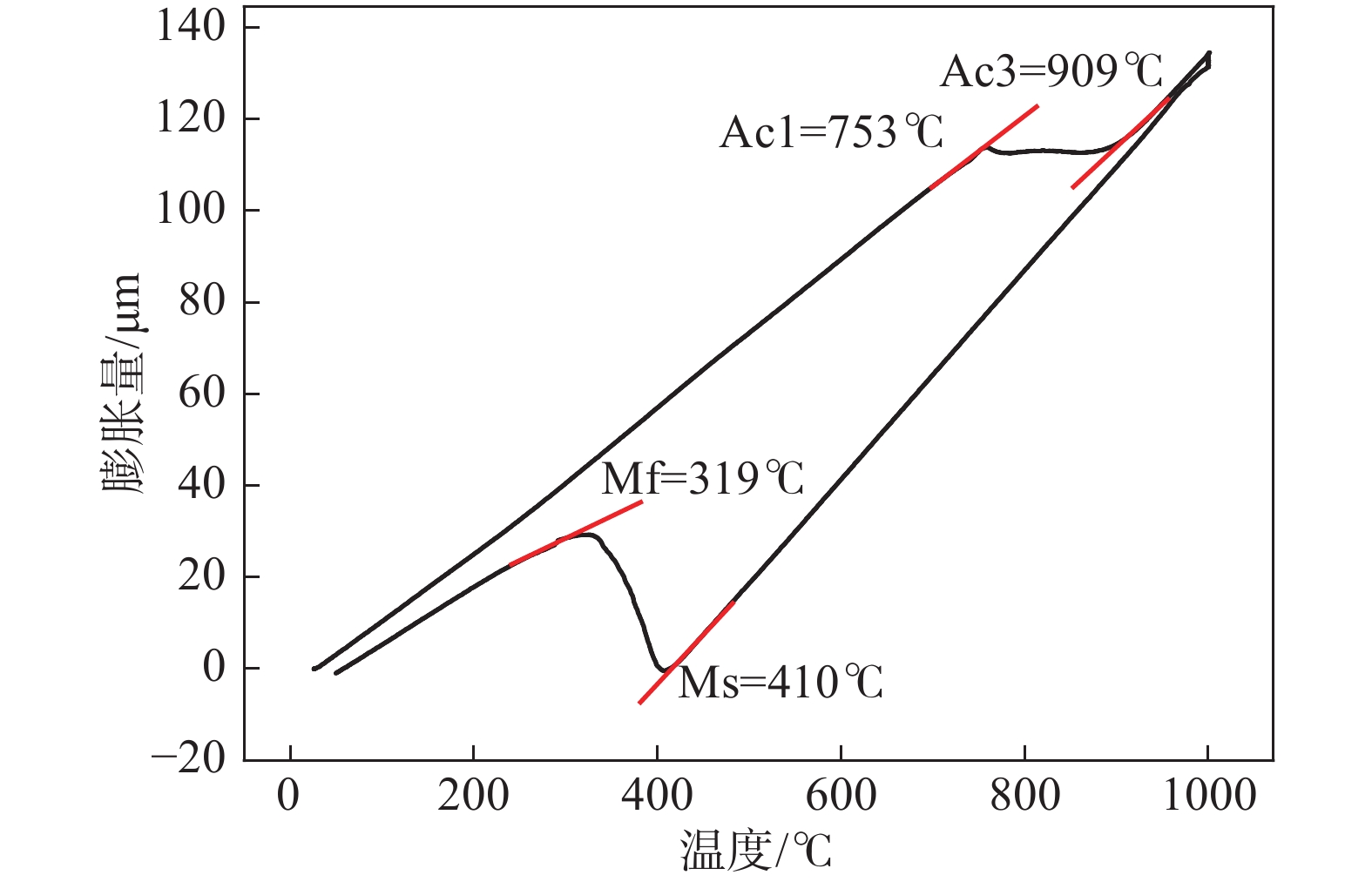
 下载:
下载:
